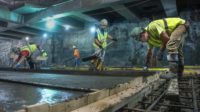Sometimes the solution to a complex problem is right in front of our eyes. If we look at the issue of carbon reduction differently than we have so far, one opportunity lies in reexamining fundamental floor-loading assumptions. The American Society of Civil Engineers’ Structural Engineering Institute challenges engineers to reassess their designs, practices and specifications to reach a goal of net zero embodied carbon by 2050. So far, most efforts have focused on material design choices and specifications, such as cement replacements, efficient steel production (including renewable energy for steel mills) and mass timber construction.

Ron Klemencic
There has also been progress made in modifying the basic methods of building design. Performance-based design methods reduce embodied carbon by building structures that are more efficient and reliable compared to conventional designs that adhere to prescriptive code procedures. With performance-based seismic design for tall buildings now considered the standard of care in tall building seismic design, there is great promise that performance-based wind and structural fire design, now in early stages of implementation, will cut embodied carbon as well.
Still, little attention has been given to the most basic and simple parameters of structural engineering—the lowest hanging fruit. By reevaluating basic loading requirements prescribed in ASCE-7, the society’s widely used standard for minimum design loads, a substantial cut in material consumption can be achieved.
One current example relates to the design of “collaboration spaces,” which are prevalent in most commercial offices today, especially in the tech sector. Most American code enforcement jurisdictions interpret these collaboration spaces as “assembly-occupancy” uses for the purposes of exit calculations.
As a result, structural engineers are compelled to design floor systems supporting these areas considering an excessive 100-psf, non-reducible live load. The result: millions of tons of unnecessary embodied carbon.
Loading diversity is another example worth considering. For instance, in a sports facility the number of people entering the stadium or arena is known and controlled. So why are engineers required to consider all those people occupying simultaneously all venue areas—from the entire seating bowl to the stacked concourses to the back of the house? This condition cannot exist, but engineers continue to design structures as if it could. There are many other examples.
Of course, with any change comes apprehension and resistance. Why alter something that has seemingly worked for decades? What about increased floor deflections or vibrations? Don’t these ideas apply mainly to tall buildings? What about the others? And why take on more risk?
All valid questions, and they underscore the need for science and research. But with thoughtful consideration of how buildings are used now and in the future new recommendations will emerge.
The point is that the simplest and easiest changes to be made are also the most overlooked, and the demand side of the design equation needs rethinking. Remember, building construction and operations are the source of about 39% of all greenhouse gas emissions and are a key to slowing climate change.
In recent months there have been many distractions from the emergency posed by climate change. It is important to regain our focus. Research efforts are being organized in the U.S. through ASCE and in the U.K. through the Institution of Structural Engineers (IStructE ) to study actual floor loading demands for many different conditions. Better requirements will be the result.
The Charles Pankow Foundation believes these efforts are critical steps toward successfully achieving the goals of SE2050. It is leading a coalition of funding partners and coordinating with our IStructE colleagues in the U.K., where complementary efforts are underway. I challenge you to join this effort, starting with a visit to the foundation website, PankowFoundation.org. Engineers can change the world for the better and the easy, simple-to-enact steps are right in front of our eyes.






